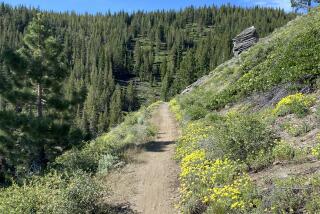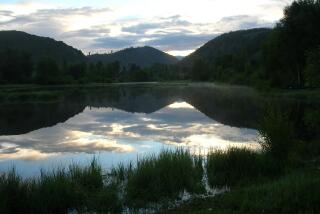New Beginnings at Journey’s End
- Share via
So what do people do after spending three months pushing and pulling handcarts and wagons 1,100 miles across the plains?
For the most part, they go back to their homes and their ordinary lives.
Ted Moore will return to gold prospecting and finish setting up a mobile home park. Tom and Linda Whitaker will return to run their hair salon in Washington.
But saying that we will be returning to our ordinary lives is not to say that we will return as we left. We are stronger, we have been tested by rain, cold, hail, ice, pain, fatigue and burning sun, and we have triumphed.
If there is one thing that this trail has given us, it is a sense of industry--a certain confidence that we can join in a good cause.
When we finally made it to Salt Lake City last week, most of us just wanted to crawl into bed and rest, but people were so excited that we donned our pioneer-style dresses and bonnets yet another time to join in public celebration.
The first pioneer company reached the end of the trail above the Great Salt Lake 150 years ago without celebration, of course. Instead, they pulled plows off their wagons, broke up soil and planted potatoes. It was July 24, and they had only a month and a half left in the growing season.
In all, nearly 70,000 pioneer settlers took the Mormon Trail west. When they arrived, they went right to work building homes, stores, mills and churches.
Following their example, we of the reenactment company will put away the costumes and get busy.
Maren Clark, 17, of Cedar City, Utah, has a specific task in mind: “I’m going to go right home and sell all my stuff because now I know I don’t need it. Our lives are so complicated and we’ve seen out here that it doesn’t have to be that way.”
In 97 days on the trail, the wagon train never failed to complete the day’s journey.
In the handcart crews, our favorite pioneer gumption story is that of a lone woman who pushed a handcart all the way across the plains, over the Continental Divide, and up Big Mountain. Then she gave her handcart a mighty shove and sent it crashing down the cliff end over end, and she walked into the valley with nothing.
Mike Dunn of Whittier served as captain of the handcart company. He wants to settle down as an apple or potato farmer in Washington.
“The work is the best part. It’s just fun--work is fun if you let it be,” he says.
Unbelievable as it sounds, we didn’t lose one person from the 150-member full-time crew that started out on the banks of the Missouri River three months ago.
As we approached North Platte, Neb., Gordon Beharrell, 59, of Lancashire, England, became ill and was rushed to the emergency room. Surgery was performed to remove a blockage caused by a previous surgery, and he lay in the hospital for days. As soon as he was released, though, he was back with us--riding until his strength returned and he could walk.
Carli Wilson, 18, of Huntington Beach, was also among those who had to leave the trail for medical help. After three days of treatment, though, she returned to the trail “because it rocks,” she said.
Any person who has completed all or even part of this trip--nearly 10,000 people joined in along the way for anywhere from a day to weeks--would be difficult to convince that there was anything impossible.
But there is so much to be done in our own homes and communities that to pine for the “good old days” of the trail would be a waste of effort.
Sarah Robinson, 23, of West Jordan, Utah, will work with troubled teens in the deserts of Arizona. Gil “Pete” Petramalo, 61, of Burly, Idaho, will be moving to Ohio to help his son farm.
For Henry Clarence Bently, the trail was about beginnings. He was born July 12 in a canvas tent at Fort Bridger, Wyo. At 8 pounds, 4 ounces, he joined his parents on the trail.
He has been a reminder to all of us who have survived this arduous journey, that reaching our destination is not about endings, but about beginnings.
More to Read
Sign up for The Wild
We’ll help you find the best places to hike, bike and run, as well as the perfect silent spots for meditation and yoga.
You may occasionally receive promotional content from the Los Angeles Times.






